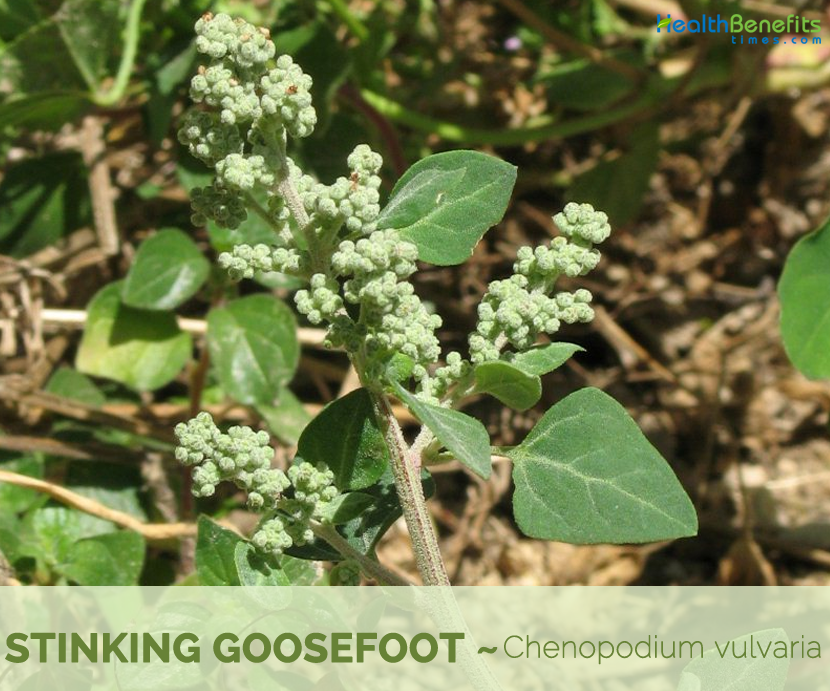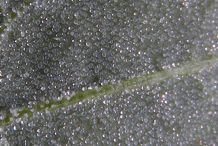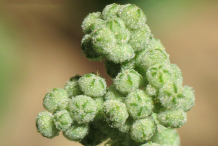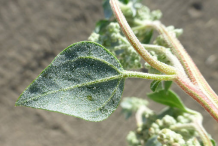Plant Description
Stinking goosefoot is a foul smelling annual Herb that grows about 10-60 cm tall. The plant is found growing along hedges, bushes (nutrient riches), caves on lime slopes, salt marshes, pebbly beaches, ruderale sites, mess corners at farms, fallow land, waste heaps, vegetable gardens, along roads and along walls. The plant prefers moderately moist, very nutrient-rich, usually highly fertilized, often calcareous, reprocessed soil (sand, marl and stony places). Stem is erect, much branched, spreading or ascendant and 5-10 cm long.
Leaves
The stalked leaves are oval, wedge-shaped at the base, about 1/2 inches long. Leaf blade grey-farinose especially beneath, greener above, longer than or equal to petiole, 0.5-3 cm long, broadly trullate or broadly ovate to ovate, margin entire, in large leaves sometimes with a fairly acute angle on each margin at broadest part, base truncate to short attenuate, apex obtuse to acute.
Flower & Fruit
Its small flowers are grouped in short inflorescences that are axillary and terminal. They have 5 farinaceous tepals that measure 0.5-0.8 mm in length, 5 stamens and a pistil. They usually open between June and October. There are no petals and the flowers are wind-fertilized. Its fruits are membranous, surrounded by the tepals and contain a single seed of dark brown and gleaming, which has a shape reminiscent of a casserole with its lid and measures 1-1.5 mm in diameter.
The whole plant is covered with a white, greasy mealiness, giving it a grey-green appearance which when touched, gives out a very objectionable and enduring odor, like that of stale salt fish, and accounts for its common popular name: Stinking Goosefoot.
Traditional uses and benefits of Stinking Goosefoot
- Whole plant is antispasmodic and emenagogue used to expel worms from the bowel.
- It is also used for the fungal infections and as a cardiac stimulant.
- It is a form of treatment for acute gout.
- An infusion of the dried leaves is used in the treatment of hysteria and nervous troubles connected with women’s ailments.
- In Chinese medicine wormseed oil is used for rheumatism, eczema and bites.
Culinary Uses
- Leaves and flower buds are cooked and used like spinach.
- Raw leaves should only be eaten in small quantities.
- Seed cooked and ground into a powder, mixed with wheat or other cereals and used in making bread etc.
Other Facts
- Seed is small and fiddly; it should be soaked in water overnight and thoroughly rinsed before it is used in order to remove any saponins.
- Gold/green dyes can be obtained from the whole plant.
Precautions
- People with a tendency to rheumatism, arthritis, gout, kidney stones or hyperacidity should take especial caution if including this plant in their diet since it can aggravate their condition.
- Wild arrach is not recommended in pregnant or breastfeeding women due to a lack of available scientific evidence.
References:
https://www.itis.gov/servlet/SingleRpt/SingleRpt?search_topic=TSN&search_value=20637#null
https://davesgarden.com/guides/pf/go/74004/
https://npgsweb.ars-grin.gov/gringlobal/taxonomydetail.aspx?id=10196
https://www.cabi.org/isc/datasheet/113243
https://www.botanical.com/botanical/mgmh/a/arrac059.html
http://www.pfaf.org/user/Plant.aspx?LatinName=Chenopodium+vulvaria
http://www.theplantlist.org/tpl1.1/record/kew-2717921
https://plants.usda.gov/core/profile?symbol=CHVU
https://en.wikipedia.org/wiki/Chenopodium_vulvaria
http://www.floracatalana.net/chenopodium-vulvaria-l-
Comments
comments
| Stinking Goosefoot Quick Facts | |
|---|---|
| Name: | Stinking Goosefoot |
| Scientific Name: | Chenopodium vulvaria |
| Origin | Mountainous regions of Europe, North America and Asia |
| Shapes | Achenes depressed-ovoid; pericarp adherent, smooth |
| Health benefits | Used in the treatment of hysteria and nervous troubles connected with women's ailments |



